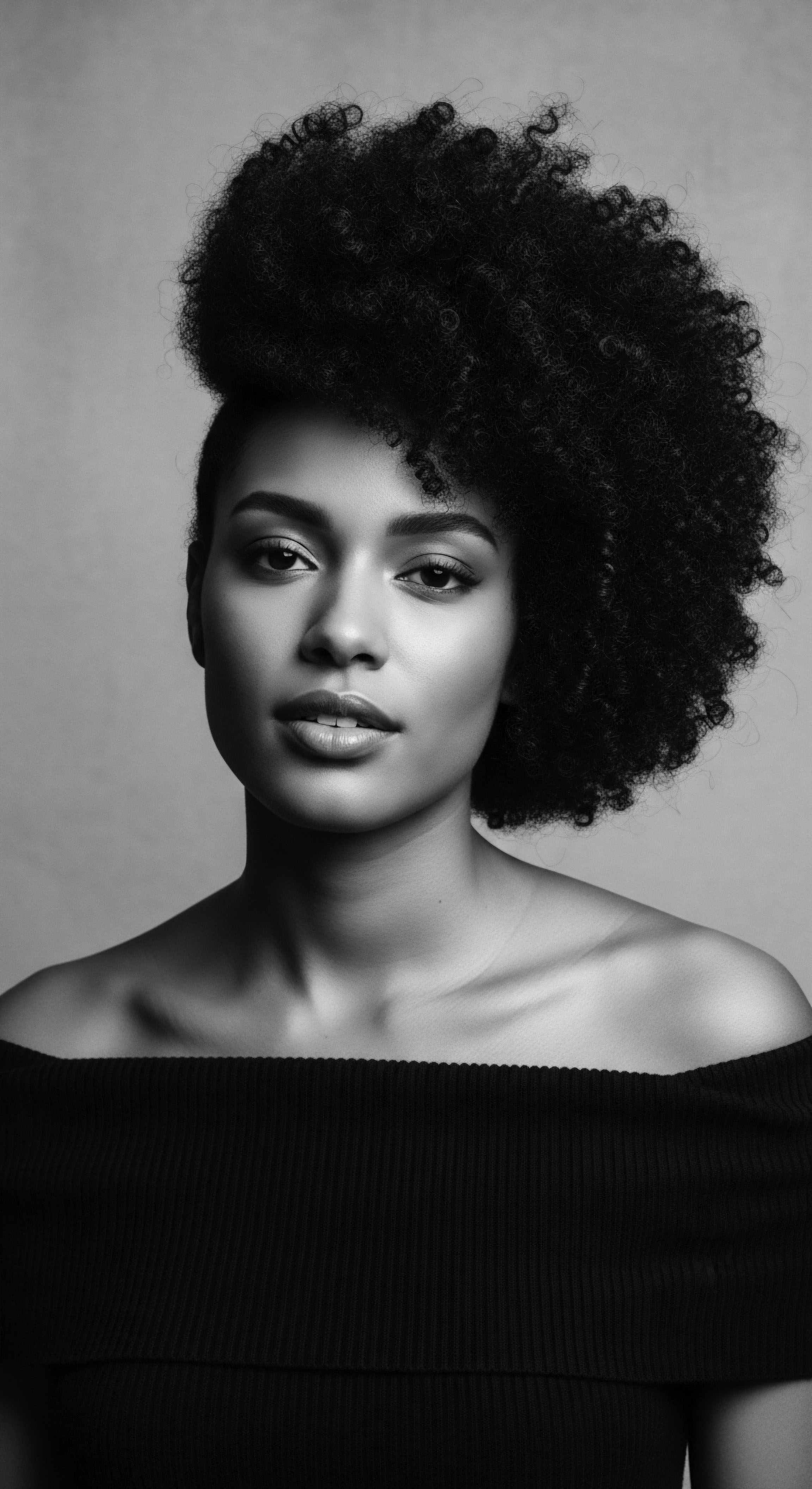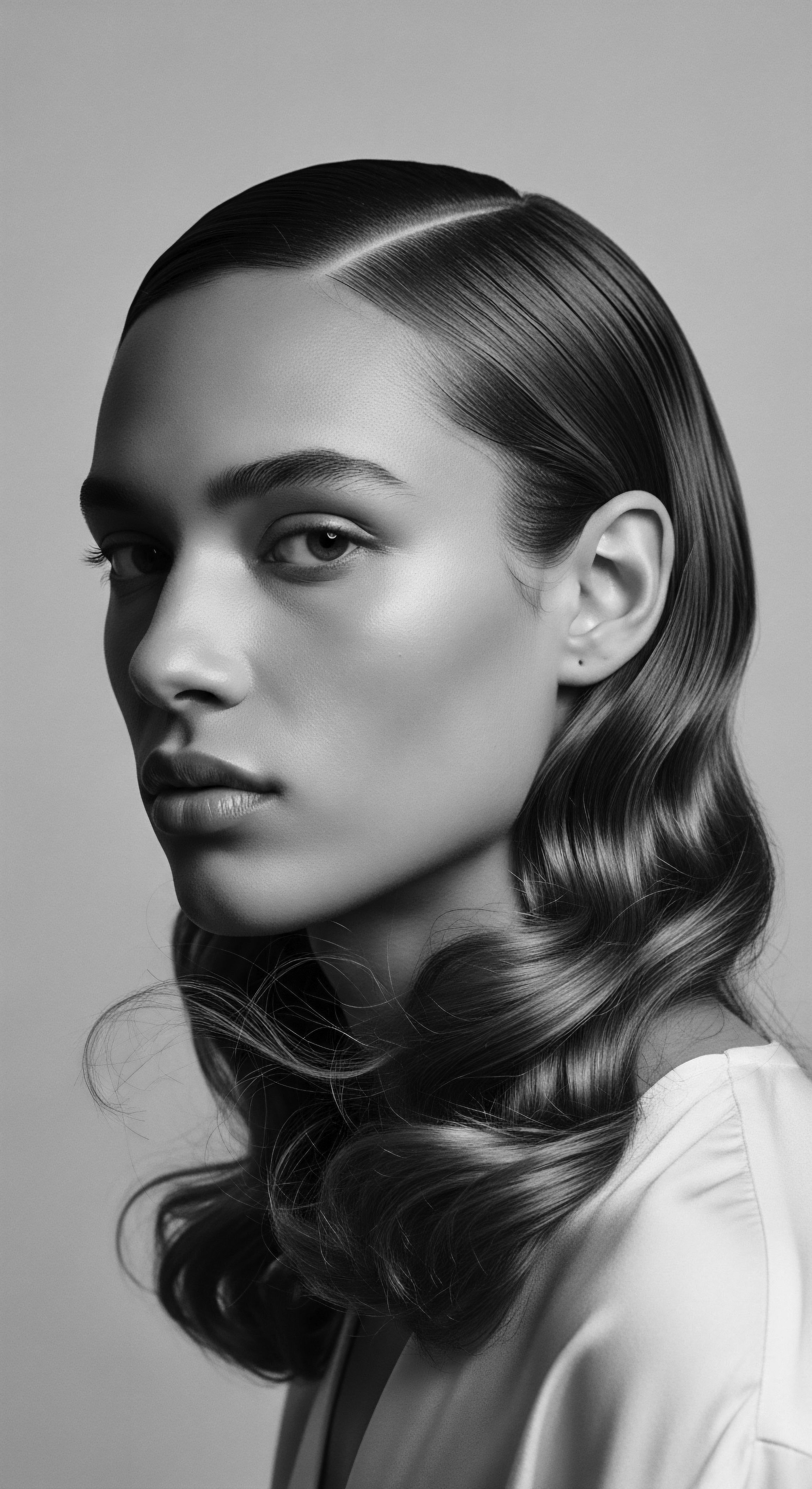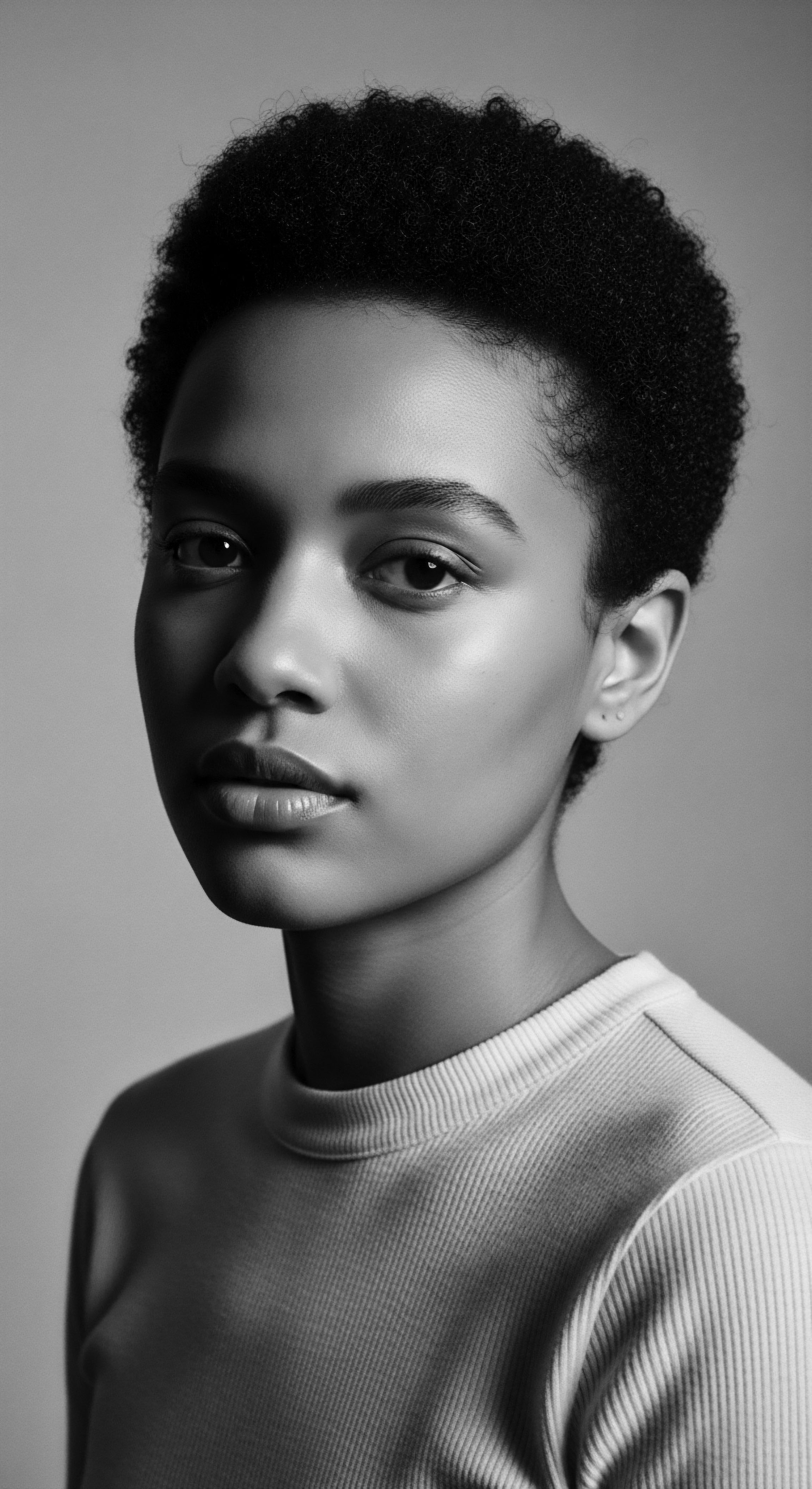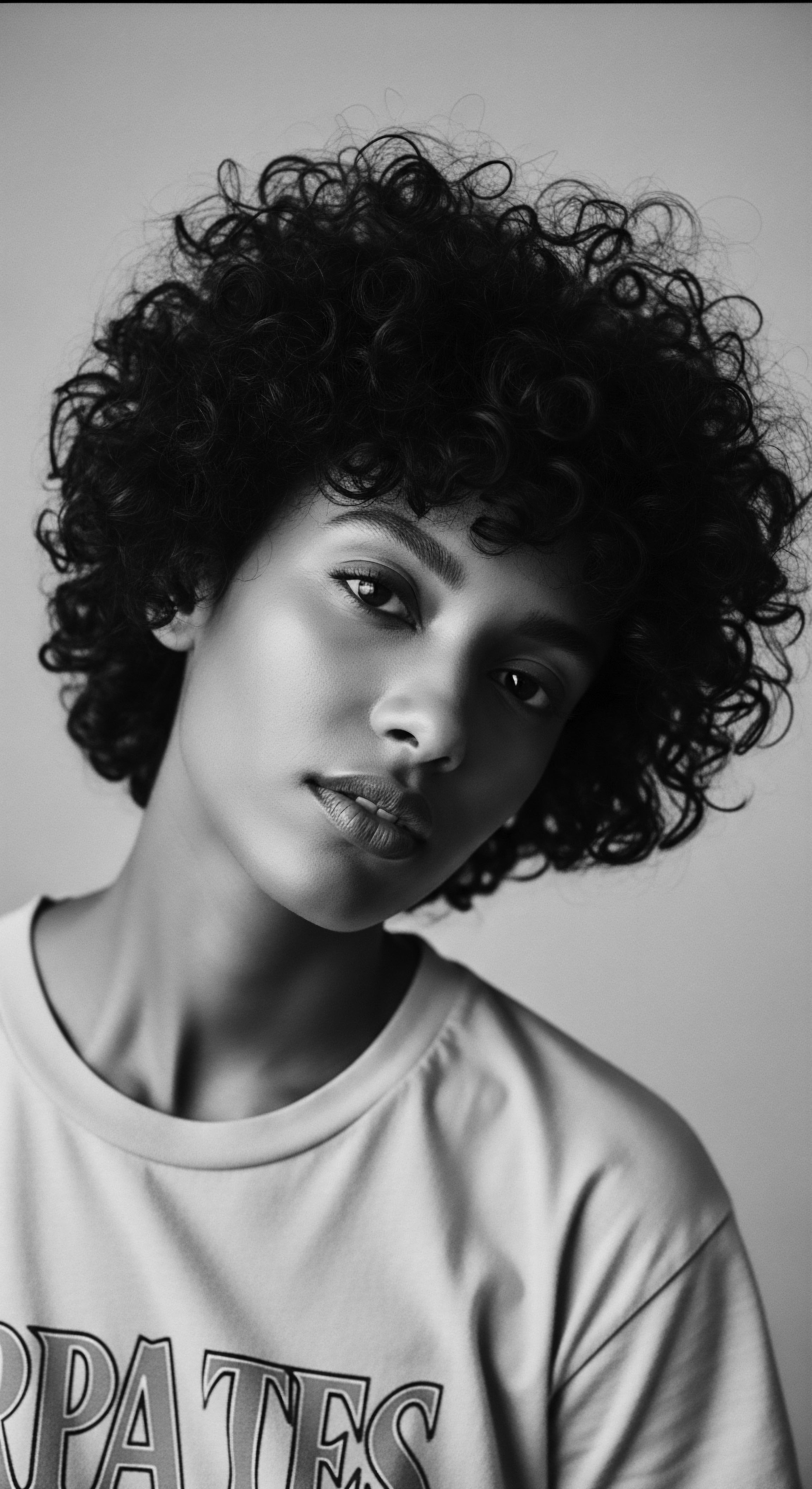
Roots
There exists a profound memory held within each coil, every wave, and the unique curvature of every strand of hair that graces our crowns. It is a story whispered across generations, etched not merely in the chronicles of human endeavor, but deeply inscribed within the very helix of our being. We speak of hair, certainly, but more precisely, we speak of textured hair —a living testament to lineage, an enduring symbol of resistance, beauty, and identity that pulses with the heartbeat of ancestral lands and journeys.
When we seek to understand how genetics gives shape to this magnificent aspect of our physicality, we are not just tracing biological pathways. We are, in a deeper sense, honoring a complex heritage, exploring the very soul of a strand as it carries forward the wisdom of its origins.
The conversation surrounding textured hair heritage extends far beyond the surface, reaching into the microscopic architecture of the hair shaft and the very genes that orchestrate its intricate design. What allows some hair to coil tightly, others to form graceful waves, and still others to stand with proud defiance? The answers lie within our genetic blueprint, a testament to adaptations forged over millennia. Think of the follicle’s unique form , often elliptical or kidney-shaped in highly coiled hair, dictating the emergent strand’s curvature.
This departure from a perfectly circular cross-section is a fundamental architectural choice made by our bodies, influenced by a specific set of inherited instructions. This intrinsic design is a direct link to our forebears, whose hair types served pragmatic purposes—from thermal regulation in sun-drenched climates to protection against environmental elements.
The journey to comprehend the intricate anatomy of hair specific to various textures, particularly those prevalent in Black and mixed-race communities, draws from both ancient observations and modern scientific revelation. Long before microscopes unveiled the elliptical nature of a hair follicle, communities understood the distinct properties of their hair. They recognized its unique requirements for care, its strength, its elasticity, and its natural propensity to form coils and kinks.
This understanding formed the bedrock of ancestral hair care practices , which were finely tuned responses to the genetic dictates of their hair. Modern science now validates many of these intuitions, revealing how the distribution of keratin and melanin within the hair fiber itself contributes to its unique mechanical properties, its luster, and its characteristic spring.
The genetic script for textured hair unfolds a story of deep heritage, defining not just physical form but also a legacy of resilience and cultural expression.
In charting the lexicon of textured hair, we often employ terms that seek to categorize and describe its immense variety. Systems of classification, while sometimes reductive, attempt to capture the spectrum of curl patterns, from broad waves to tightly packed Z-patterns. Understanding these descriptions, whether they are modern numerical classifications or more traditional, experiential designations, helps us appreciate the genetic continuum. Some of these classifications, though contemporary, nod to an underlying recognition that different hair textures present distinct challenges and opportunities, observations that were surely made by those who first combed and styled this hair in ancient times.
The very language we use reflects a persistent human endeavor to comprehend and honor this inherited aspect of self. The essential lexicon includes:
- Coil ❉ A tight, spring-like curl often seen in highly textured hair, forming small, distinct spirals.
- Kink ❉ A sharp, angular bend in the hair strand, contributing to dense, voluminous textures and often resisting elongation.
- Wave ❉ A gentle, undulating pattern in the hair, less coiled than a curl but still possessing distinct movement and shape.
- Follicle Shape ❉ The elliptical or kidney-shaped opening in the skin from which textured hair grows, dictating the curl pattern.
The growth cycles of hair, while universal, interact subtly with the genetic predispositions for texture. The length of the anagen (growth) phase, the robustness of the follicle, and the density of hair follicles on the scalp all have genetic components. For many with highly textured hair, the anagen phase can be shorter, limiting length retention, a natural adaptation that perhaps served ancestral communities by preventing excessive tangling in challenging environments. The interplay between genetics, environmental factors, and historical nutrition likely played a role in shaping these cycles over time.
What we see today, then, are not just isolated biological traits, but the cumulative effects of generations living, adapting, and innovating with their hair, their practices a living echo of their genetic inheritance. Consider the nutritional wisdom of our ancestors, whose diets rich in local flora and fauna undoubtedly supported hair health, influencing the very expression of these genetic instructions. This connection between diet and hair vitality is not a modern discovery; it is a foundational aspect of ancestured wellness passed down through oral tradition and communal practice.

How Do Specific Gene Variants Influence Textured Hair Shapes?
At the heart of the genetic orchestration of textured hair lies a complex interplay of gene variants, each contributing to the nuanced expressions we see. Research has identified several genes that play significant roles in determining hair shape, thickness, and even color. For textured hair, particular attention falls on genes involved in the development of the hair follicle and the proteins that comprise the hair shaft. The precise arrangement and distribution of these proteins, guided by genetic code, dictates the mechanical properties of the hair, influencing its elasticity, strength, and tendency to curl.
The variations in these genes, inherited from our ancestors, are responsible for the vast diversity within textured hair, from loose waves to tight coils. Understanding these genetic underpinnings allows us to appreciate the biological basis of textured hair’s inherent beauty and its adaptive strengths.
For instance, single nucleotide polymorphisms (SNPs) in genes such as EDAR (ectodysplasin A receptor) have been linked to hair thickness and straightness. While EDAR variations are often discussed in the context of East Asian hair, it is the cumulative effect and unique combinations of numerous genetic markers that account for the extraordinary range of curl patterns across populations of African and mixed-race descent. Another gene, TCHH (trichohyalin), influences the bundling of intermediate filament proteins in the hair shaft, contributing to hair strength and texture. The distinct shape of the hair follicle, which is largely genetically determined, is a primary driver of curl.
A more elliptical follicle produces a more curled hair shaft because the keratinocytes, the cells that produce keratin, are distributed unevenly, causing the hair to grow in a curved manner. This biological reality underpins the specific care needs and styling possibilities unique to heritage hair types .
| Aspect of Hair Curl Pattern |
| Ancestral Observation (Heritage Context) Recognized as a natural, inherited trait; often linked to family lines and distinct ethnic groups. Observed differences in ease of knotting, length retention. |
| Modern Genetic Understanding Determined by follicle shape (elliptical/kidney-shaped), distribution of keratinocytes, and specific gene variants affecting hair shaft proteins (e.g. TCHH, TRIC) and follicle development. |
| Aspect of Hair Hair Thickness |
| Ancestral Observation (Heritage Context) Understood through tactile experience; perceived as strong or delicate; influenced by diet and communal health practices. |
| Modern Genetic Understanding Influenced by genes like EDAR, and the overall volume of keratinized cells in the hair fiber. Genetic variations lead to differences in diameter. |
| Aspect of Hair Hair Density |
| Ancestral Observation (Heritage Context) Noted through visual observation of scalp coverage; associated with vitality and overall wellbeing. |
| Modern Genetic Understanding Governed by the number of active hair follicles on the scalp, which has a significant inherited component. |
| Aspect of Hair Understanding the genetic underpinnings of textured hair allows for a deeper appreciation of its inherited strengths and unique care requirements, connecting modern science with ancestral knowledge. |
The pioneering work of Nina Jablonski (2012) on human skin color and its adaptive significance offers a parallel for understanding hair texture. Just as skin pigmentation evolved as a response to varying levels of solar radiation, hair texture, particularly tightly coiled hair, is theorized to have offered thermoregulatory advantages in equatorial regions. This genetic adaptation, passed down through generations, became a hallmark of certain ancestral groups. The presence of such hair would have protected the scalp from intense UV radiation while allowing for efficient cooling of the head through evaporative sweat.
This ancestral function provides a compelling narrative for why these genetic traits persisted and flourished, becoming an integral part of Black and mixed-race heritage across the globe. The story of our hair, then, is inextricably linked to the story of human migration and adaptation.

Ritual
The inherent genetic characteristics of textured hair have profoundly shaped the rituals, techniques, and tools employed for its care and adornment throughout history. From the intricate braiding patterns of ancient West Africa to the elaborate coiffures of the Caribbean, these practices were not merely aesthetic choices. They were sophisticated responses to the specific needs of genetically textured strands, imbued with cultural meaning and passed down as cherished heritage . The way hair behaves—its shrinkage, its density, its propensity for tangling—directly influenced the development of protective styles, traditional cleansing methods, and the very act of collective hair grooming that became central to community life.
Consider the protective styling encyclopaedia, a living archive of techniques honed over centuries. Styles like cornrows, twists, and locs, rooted in African civilizations, exemplify a profound understanding of how to protect delicate, coiling strands from breakage, environmental aggressors, and tangling. These styles encapsulate a wisdom that recognized the genetic predisposition of textured hair to be drier and more susceptible to damage if left unmanaged. By braiding or twisting the hair, the cuticle layers are shielded, moisture is retained, and the need for daily manipulation is reduced.
This is a direct, practical response to the genetic architecture of the hair, elevated to an art form. These protective styles, often embellished with cowrie shells, beads, or threads, also served as visual narratives—marking age, marital status, social rank, or spiritual affiliations. They represent a tangible link to our ancestral craftsmanship and the ingenious ways communities adapted to their hair’s genetic reality.
Natural styling and definition techniques, too, were shaped by the hair’s genetic blueprint. The desire to enhance or define natural curl patterns, rather than suppress them, led to the development of methods that worked harmoniously with the hair’s inherent structure. Techniques involving specific plant extracts, oils, and butters were used to clump curls, add shine, and provide hold without compromising the hair’s integrity. These methods often relied on ingredients readily available in the local environment, a testament to the symbiotic relationship between humans, nature, and their inherited physical traits.
The practice of co-washing or using clay-based cleansers, which are seeing a resurgence today, mirrors ancestral practices that prioritized gentle cleansing to preserve the hair’s natural oils, which are crucial for maintaining the hydration levels of genetically dryer hair types. This gentle approach safeguards the unique protein structure of highly textured hair, a structure susceptible to harsh stripping agents.
Ancestral hair rituals, born from a deep understanding of textured hair’s genetic makeup, continue to shape contemporary care practices, connecting us to a rich, enduring heritage.
The history of wigs and hair extensions also offers a fascinating glimpse into how communities adapted to hair genetics and societal ideals. From the elaborate human-hair wigs of ancient Egypt, used by royalty and commoners alike for protection from the sun, hygiene, and ceremonial purposes, to the intricate hairpieces of West African cultures, these adornments often compensated for perceived genetic limitations or served as potent symbols of status and artistry. In many societies, the ability to create longer, fuller styles through extensions offered a creative outlet that worked with, or sometimes transcended, the natural growth patterns of genetically defined hair.
These practices underline the human desire for self-expression and adaptation, where genetic realities were not barriers but prompts for ingenious solutions and artistic display. These extensions, often made from natural fibers or human hair, were integrated with the wearer’s own genetic hair, allowing for diverse styles that might not have been naturally achievable.
The complete textured hair toolkit, whether ancient or modern, speaks volumes about the continuous human effort to care for these unique strands. Traditional tools often included combs carved from wood or bone, used to detangle and sculpt, or gourds and natural sponges for applying treatments. These tools were designed to minimize breakage and work with the hair’s natural curl, rather than against it.
Today’s toolkit might include wide-tooth combs, satin-lined bonnets, and specific applicators, but the underlying principle remains the same ❉ to provide gentle, effective care that respects the hair’s genetically determined structure. The continuity of these tools, some refined, others rediscovered, forms another vital link in the chain of hair heritage .
The cultural significance of hair within Black and mixed-race communities cannot be overstated. Hair has served as a powerful medium for communication, a marker of identity, and a symbol of resistance against oppressive beauty standards. The genetic legacy of textured hair became a focal point during periods of enslavement and colonialism, where attempts were made to strip individuals of their cultural identity, including their hair practices. Yet, even in the face of immense adversity, traditional styles and care methods persisted, often underground, becoming acts of defiant self-preservation.
This resilience, deeply interwoven with the genetic makeup of the hair itself, speaks to a powerful ancestral spirit that refused to be extinguished. The care and styling of textured hair became a quiet, yet potent, act of reclaiming one’s narrative, a continuous thread connecting past struggles to present triumphs.

Relay
To truly comprehend how genetics shapes textured hair, one must journey beyond surface appearances, delving into the intricate biological mechanisms that dictate curl, density, and strength. This deep understanding, however, is never divorced from the profound cultural and historical context in which textured hair has existed. The scientific revelations concerning specific gene variants and their influence on hair morphology serve to affirm and illuminate the long-held wisdom embedded in ancestral hair practices and the resilience of communities who have consistently honored their hair’s inherited characteristics.
At a molecular level, the genetic instructions for textured hair are remarkably complex. We know that the shape of the hair follicle—whether it’s round, oval, or flat—is a primary determinant of curl. A flatter, more asymmetrical follicle produces more highly coiled hair. This fundamental anatomical difference is guided by a suite of genes.
For instance, specific alleles of the gene TCHH, which produces the protein trichohyalin, a component of the inner root sheath and hair shaft, have been strongly associated with hair texture, particularly in populations of African descent. Variations in other genes, such as FGFR2 and WNT10A, also influence hair growth and development, contributing to the rich spectrum of textured hair types. These genetic predispositions mean that the hair is, from its very inception, programmed to exhibit certain characteristics, which then require particular forms of care, a fact understood by our ancestors long before the advent of genetic sequencing.
A compelling statistic that underscores this genetic legacy comes from the research on the diversity of hair types. Studies have shown that African populations exhibit the greatest genetic diversity in hair texture compared to any other continental group. For example, a study by Adhikari and colleagues (2016) identified several genetic loci associated with hair morphology, noting that variants associated with tightly curled hair are found predominantly in populations of African ancestry.
This scientific finding corroborates the immense phenotypic diversity observed within Black and mixed-race hair , from loose waves to very tight coils, and provides a powerful biological basis for the rich array of traditional styling and care practices that have flourished across the African diaspora. This genetic tapestry is a testament to deep historical roots and diverse ancestral migrations across the African continent.
Genetic research provides compelling evidence of textured hair’s profound diversity, affirming the deep ancestral roots and unique care needs recognized by historical practices.
The interplay between these genetic predispositions and environmental factors offers another layer of insight. While genetics provides the blueprint, elements such as nutrition, climate, and overall health can influence how those genes are expressed, affecting hair health and appearance. Ancestral wisdom often recognized this connection implicitly, crafting diets and lifestyle practices that supported robust hair growth and scalp health.
The consumption of nutrient-rich indigenous foods, the use of natural oils and butters for protection from sun and dryness, and communal grooming practices all served to optimize the expression of these inherited hair characteristics. The practices were not just about aesthetics; they were holistic approaches to wellbeing, directly influencing the vitality of hair shaped by generations of genetic adaptation.
The socio-cultural ramifications of these genetic differences are profound. During eras of global expansion and forced migration, particularly the transatlantic slave trade, the genetic reality of textured hair became a point of both struggle and powerful identity. European beauty standards, often predicated on straight or loosely wavy hair, sought to devalue and suppress the natural beauty of textured hair. Yet, through this very suppression, hair became a potent symbol of resistance and self-affirmation .
Secreted knowledge of traditional care practices persisted, passed down through oral traditions and clandestine gatherings. The genetic traits that determined hair texture were woven into the very fabric of identity, becoming an undeniable link to a stolen heritage. The continued existence and celebration of diverse textured hair styles today are a direct lineage from this historical defiance, a testament to the enduring strength of genetic and cultural legacy.
Contemporary genetic studies are now validating many aspects of ancestral hair care. For example, the understanding that highly coiled hair tends to be naturally drier, due to the difficulty of scalp oils traveling down the spiral shaft, explains the ancestral reliance on heavy emollients like shea butter and castor oil. Similarly, the genetic predisposition to breakage due to the unique protein structure of highly textured hair underscores the wisdom of protective styling.
This modern scientific lens allows for a more informed and respectful appreciation of traditional practices , moving beyond anecdotal evidence to biochemical validation. This synergy between ancient wisdom and scientific discovery deepens our reverence for textured hair and its profound ancestral connections .
- Shea Butter ❉ A rich emollient derived from the shea tree, traditionally used across West Africa for its moisturizing and protective properties, particularly beneficial for genetically dry, textured hair.
- Castor Oil ❉ Extracted from castor beans, a staple in many traditional hair care regimens for its density and perceived ability to strengthen hair and promote growth, supporting genetically predisposed hair health.
- Kukui Nut Oil ❉ A lightweight oil used in Hawaiian traditions, offering deep penetration and moisture for hair types that might otherwise struggle with dryness due to their inherent structure.
- Amla ❉ A potent Indian gooseberry, revered in Ayurvedic practices for stimulating hair growth and preventing premature graying, working with the hair’s natural genetic lifecycle.
The historical trajectory of textured hair, from an adaptive biological trait to a contested symbol, and now to a celebrated aspect of identity, mirrors the ongoing narrative of self-discovery and reclaiming. The more we understand the genetic blueprint that gives rise to textured hair, the more profoundly we can appreciate the ingenuity of our ancestors, whose care rituals were often sophisticated, intuitive responses to these very genetic realities. It is a dialogue between the past and the present, a recognition that the helix within each strand carries stories not just of biology, but of profound cultural survival and beauty .

Reflection
The intricate dance between our genetic inheritance and the outward expression of textured hair is a story that refuses simple reduction. It is a profound meditation, woven from the deepest strands of our being and the collective memory of our forebears. As we have explored the foundational biological truths, the enduring cultural rituals, and the deeper societal ramifications, it becomes clear that understanding how genetics shapes textured hair is not merely an academic pursuit. It is an act of acknowledging a living, breathing archive—a profound library of Textured Hair Heritage that speaks volumes about who we are and where we come from.
Every curl, every wave, every coily strand carries within it the echoes of countless generations. It speaks of survival, adaptation, creativity, and persistent beauty in the face of shifting landscapes, both physical and cultural. Our hair is a tangible, ever-present link to ancestral wisdom, a testament to the ingenuity and care practices developed over millennia in response to its unique genetic blueprint. This understanding invites us to view our hair not as something to be managed or altered to fit an external ideal, but as a sacred extension of our identity, a precious inheritance to be honored and nurtured.
The journey of textured hair—from the elemental biology of the follicle to its role in voicing identity and shaping futures—is a continuous flow. It reminds us that our bodies are indeed vessels of history, and within the seemingly simple act of caring for our hair, we are engaging in a timeless ritual that connects us to a vibrant lineage. This connection is the very essence of the soul of a strand , a quiet whisper from the past that guides us toward a future where every texture is celebrated, understood, and revered for the unique story it tells.

References
- Adhikari, K. et al. (2016). A genome-wide association study of hair morphology in Europeans. Journal of Investigative Dermatology, 136(6), 1182-1189.
- Byrd, A. D. & Tharps, L. D. (2014). Hair Story ❉ Untangling the Roots of Black Hair in America. St. Martin’s Griffin.
- Jablonski, N. G. (2012). Living Color ❉ The Biological and Social Meaning of Skin Color. University of California Press.
- Morrow, J. A. (2019). The History of Hair ❉ Fashion and Adornment through the Ages. Dover Publications.
- Pollitt, P. & Huschka, J. (2000). The Art of African Textiles. Prestel.
- Robbins, C. R. (2012). Chemical and Physical Behavior of Human Hair. Springer.
- Rogers, J. & D’souza, N. (2008). Hair follicle development and the initiation of the hair cycle. Developmental Dynamics, 237(3), 577-584.
